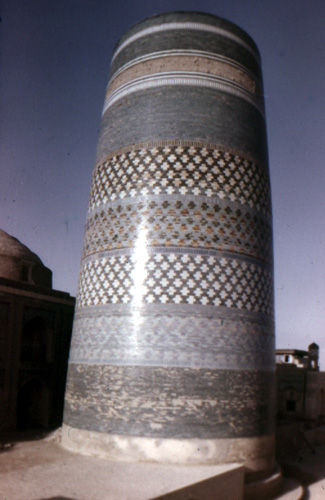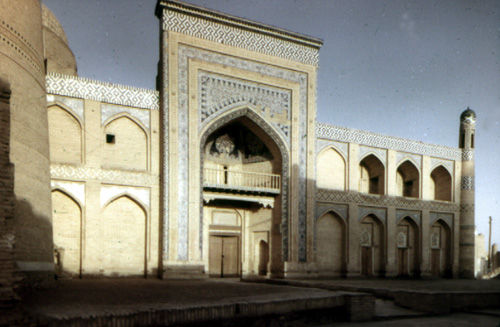Khiva is mentioned first in themanuscripts of Arab geographers from the 10th century. They describe Khiva as a city situated on the border of a desert. According to archeological data, Khiva had already existed in the 6th and 7th centuries.During 11th and 12th centuries,
Khiva was a small town-fortress. Like other towns of Khoresm, Khiva was
destroyed by the Mongolian invasion.
From the second half of the 16th
century as the capital of Khoresm, Khiva became one of the most powerful
cities of Central Asia. In the 18th century, Khiva was ruined over
nomadís forays, ruinous internal wars, and the invasion of the Iranians.
But at the beginning of the 19th century,
a new dynasty of rulers came to power. This period is characterized by
great construction works.
Majolica, marble, paintings, and carving were
widely used in construction. Khiva is divided into the inner town -
Ishan-Kala where about 60 historical monuments are located and Dishan-Kala
- the outer town where citizens of Khiva live and work. The inner town is
surrounded by a high clay fence with four gates pointing out the four
sides of the Universe.
The most ancient part of the city is the
Kunya-Arch Fortress. This building was built in the 17th century. The high
rack fence separates the fortress from housing estates. Inside the
fortress are such constructions as a palace, arsenal, offices, the mint
and a mosque.
Muhammad-Amin-Khon Madrassah (1851-1852)
is the largest madrassah in Khiva. It includes an auditorium, cells,
winter and summer mosques, and a library. Madrassah has five-cupola
entrances and a square yard surrounded by two-story cells. The brick
mosaic was used to decorate the facades, and intricate wood-carvings
flatter the entrance door. In front of the madrassah is the minaret Kalta-Minor
(1853-1855). Designed to be the highest minaret in Khiva, it did not reach
its desired height, but stands tall and stately among beautiful old
buildings and monumentsBukhara, city in western Uzbekistan, capital of Bukhara Oblast. It is located in an oasis on the Zeravshan River.
Bukhara is situated in a region producing natural gas, cotton, fruit, and silk. It has industries manufacturing textiles, carpets, and clothing, and processing astrakhan pelts.
Among Bukhara's many architectural monuments, some dating from the 9th century, are several mosques, the Ark Fortress (now a museum), and the mausoleum of Ismail Samani (9th-10th century). A teacher training college is also there.
Established by the 1st century AD, Bukhara was already an important trade and cultural centre when it was captured in the early 8th century by the Arabs. It was a leading centre of Islamic learning under the Arabs and the Persian Samanid dynasty, which held the city in the 9th and 10th centuries. It later was captured successively by the Qarakhanids and Tatars, and in 1555 it became the capital of an Uzbek emirate.
The emirate was conquered in 1866 by Russia, which held it as a protectorate from 1868 to 1920; then the emir was removed, and the city was made the capital of the Bukhara People's Soviet Republic. From 1924 to 1991 the city was incorporated into the Uzbek Soviet Socialist Republic (SSR). Uzbekistan became an independent republic in 1991.[Britannica.com]





